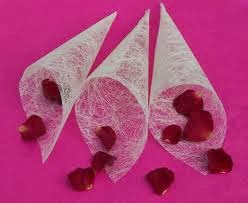Early into my study I learned that I had been making a huge amount of mistakes in my efforts to work with caramels. Everytime I tried to melt a pot of sugar I was left with a frustrating mound of crystallisation and a destroyed pan. I spoke to the Sous Chef of La Boheme who explained that there are many things that can affect the process itself, most importantly impurities in the sugar itself or a saucepan that was not perfectly clean. You can help avoid crystallisation as a result of these things by skimming the sugar with a clean ladle fight as it is coming to boiling point. I also realised that I was not supposed to put water into the pot with the sugar when it is initially melting - this had been my mistake all along. EEJIT.
Sugar work can lend the most beautiful and elegant touch to a dish when done correctly. More and more ways of creating and designing melted sugar are always being developed but there are some basic sugar working techniques that anyone can master with practice.
The most popular techniques include the sugar cage, sugar corkscrews and spun sugar. There are variations on these methods but once the classical method is learned you can lend any type of imaginative development you wish.
September girl's basic guide to sugar work:
- Use white granulated sugar - the stuff you put in your tea :) A good rule of thumb is that for every 2 cups of sugar that you use, you will make one cup of caramel.
- Be very very careful, the sugar will become extremely hot and will stick and badly burn your skin if it comes in contact with it.
- Use a heavy bottomed pan on a medium high heat. A good heavy saucepan will ensure equal heat distribution.
- Leave the sugar be - do not stir it at all. Doing so could begin crystal formation. However if crystallised lumps begin to appear at the side of the pan you can wipe these away very carefully with a pastry brush to prevent the sugar from seizing. If the sugar seizes the only thing you can do is start again.
- Different temperatures are suitable for different applications, however for the techniques I mentioned above the sugar should be cooked to a brown caramel colour. It should start to smell caramelised and you can remove it from the heat at this time.
- Now comes the most important part: allowing the sugar to cool. Most frustration with sugarwork comes from having the sugar at the wrong temperature to produce the desired results. Depending on the temperature of the room, it may need to cool for 5-10 minutes. You want the sugar to be very thick. When you lift a spoonful of it, it should be somewhat hard to remove, and should pull easily from the pan. It should not be so set that it’s brittle or breaking, but it should definitely have substance and body.
- Once your sugar is malleable you can now use it to create your sugar garnishes. In order to create a sugar basket, oil a ladle, hold it upside down and simply pull the warm sugar across it in strips. Once cooled, you can break the sugar away from the ladle to create a basket. Similarly, you can create a caramel corkscrew by trailing the stretchy sugar over an oiled steel or other long rounded apparatus. Pull the sugar whilst turning the utensil and once cooled you can slide it off to create the corkscrew.
- Spun sugar is in my opinion probably the most difficult of the techniques. Once the sugar is ready you need to hold the saucepan in one had and a fork in another. Dip the fork in the sugar syrup and stir. Remove the fork from the heat and hold it 5-6 inches above the prepared saucepan handles. Rapidly flick the fork back and forth over the handles. The sugar syrup should create very fine strands of sugar that drape over the handles. If the syrup doesn’t create any strands, or the strands have a lot of “beads,” allow the syrup to cool for another minute. If the strands are very lumpy and difficult to form, re-heat the syrup very briefly.. Continue to dip and quickly flick the fork over the handles, creating many fine strands of spun sugar. At any point, you can remove the sugar that has accumulated and shape it into balls, nests, or thin tubes as desired.
- Heated Sugar is best used immediately after it is made, as the sugar starts to liquefy if it comes into contact with anything moist or humid. If you are using it on top of a dessert, wait to position it until the last possible moment. If you want to attempt to store it, place it in a dry, airtight container.
- The condition of the saucepan you are left with following all your great productions would bring a tear to a glass eye. What I tend to do is to half fill the pot with boiling water and place it on the stove with the lid on to let the sugar all melt away. This method has in the past left me with the least amount of toil at the kitchen sink afterwards.











No comments:
Post a Comment